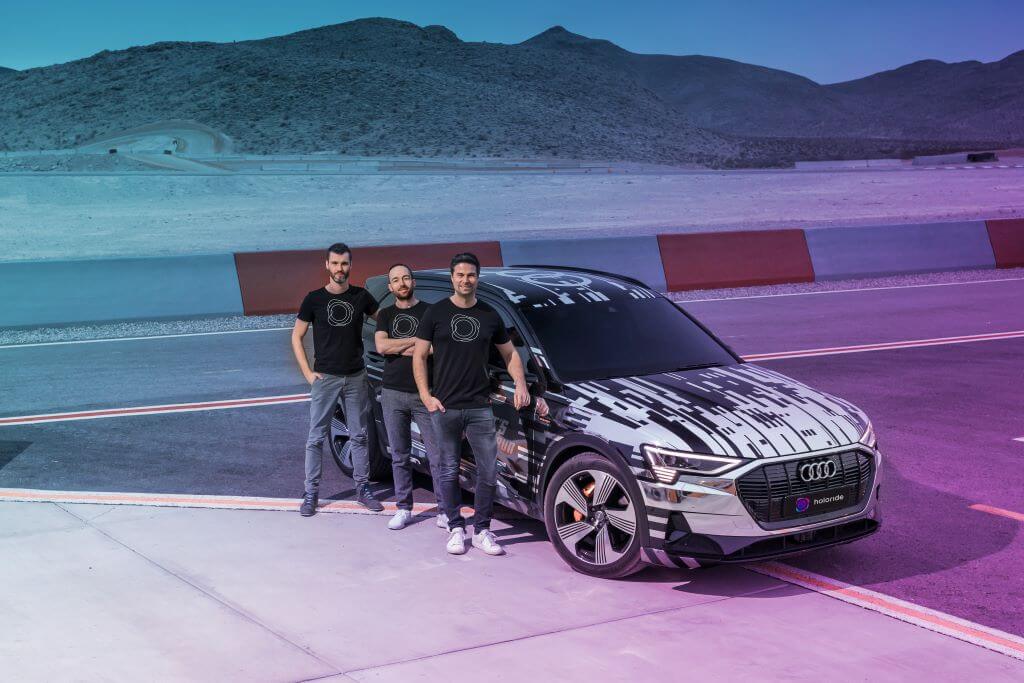We often use terms like “extended reality” and “immersive reality” interchangeably. While most of these experiences engage our eyes and ears, few engage our other senses. A German-based company holoride is looking to change that with extended reality experiences incorporating movement in a pretty creative way.
A History of Holoride
The story of holoride starts at Audi. There, co-founders Nils Wollny, Marcus Kühne, and Daniel Profendiner worked on digital projects including extended reality applications and early work in autonomous vehicles.
The group started working on combining their research on driving physics and extended reality. The result was extended reality experiences that were synchronized to the movement of the vehicle.
“A virtual vehicle is synchronized in real-time to the movement of the physical vehicle,” Wollny, now holoride CEO, told ARPost in an interview. “This creates an experience that no simulation really mock.”
The sheer entertainment potential was astounding. The “virtual vehicle” that users could ride in might be a spaceship, a flying carpet, anything. However, a more practical side became evident during testing. The immersive experience seems to drastically reduce instances of motion sickness.
Many people who ride in cars are subject to motion sickness, particularly if they’re also doing something like reading or playing a hand-held video game. Many people also get motion sickness when using VR. Wollny says that these are for the same reason – what you see and what your body feels don’t match up.
“We have the theory that if we match what you see with what you feel, people won’t get motion sickness,” said Wollny. “We can’t cure it 100% of the time… but the percentage number of people getting motion sickness with our solution is in the single digits.”

For a while, the team looked at creating their solution within Audi. However, that would severely limit the market potential. So, they left Audi and created holoride. Their independent platform means that it will one day be compatible with all car manufacturers.
The Future of Holoride
In late 2018, holoride was formed with Audi’s blessing. The car manufacturer helped with funding but only owns a small share of the company.
holoride debuted at CES 2019 and was in full swing by February. However, to tell the story from here, it makes sense to jump around a little in time.
holoride was originally intended for use in autonomous vehicles. People would have more time for in-vehicle immersive experiences if they weren’t doing things like driving. Further, being in a car that moves itself may contribute to even more motion sickness, according to Wollny.
There’s just one other thing: holoride works now and autonomous vehicles are a thing of the future.
“We didn’t want to wait until we have autonomous vehicles,” said Wollny. “No one knows when that is going to be.”
So, if holoride already works, why don’t we already have it? That gets back to the issue of being compatible with car manufacturers.
One of the biggest areas where customers are focusing in AR and VR, and especially in VR, is location-based experiences. Since this is such an attractive space, why not build an experience where you’re in a car and experiencing these created worlds?
The most important part of holoride is “elastic content” – the ability to match the extended reality experience to the feeling of being in a moving vehicle. This requires the extended reality headset to have information from the vehicle itself.
“What we need for holoride to work in private passenger cars is car data,” said Wollny. Information like speed and direction is required to sync the extended reality experience to. “To get that, we need to work closely with car manufacturers.”
The good news is that holoride made this very easy for car manufacturers. Further, being holoride-compatible adds a lot of value to vehicle without the manufacturer needing to do much themselves. The end result is that the first holoride-compatible vehicles should be rolling out within the next two years – well before most estimates for autonomous vehicles.
So, if the first holoride-compatible cars are a year or two away, what’s the news? Just like holoride wasn’t willing to sit around and wait for autonomous vehicles, they’re not willing to sit around and wait for compatible vehicles.
An Introduction to In-Car Extended Reality
“One of the biggest areas where customers are focusing in AR and VR, and especially in VR, is location-based experiences,” said Wollny. “Since this is such an attractive space, why not build an experience where you’re in a car and experiencing these created worlds?”
To be clear, when Wollney says “location-based experience,” he doesn’t mean it in the sense that the experience will only be triggered by a specific geographic location, such as location-based AR experiences. Instead, he means it in the sense that it will be based out of a physical location like a VR arcade.
This access to holoride will serve two main purposes. First, it will introduce potential future users to the idea of an immersive experience within a moving vehicle. Second, it will introduce holoride to developers. Independent developers will one day be the biggest holoride content creators.
“We are building a few applications for ourselves because they display what can be done with the [Software Developers’ Kit], but we are not content creators,” said Wollny.
The first holoride experiences will be available at select locations in a couple of weeks. That’s all that Wollny could tell us at the moment but he’d be sure to let us know as the experiences roll out.
Moving Forward
Just the idea of using extended reality in a moving vehicle may make some people queasey. For now at least. However, we’re looking forward to watching them change our minds one ride at a time.




